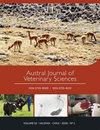阿曼阿拉伯骆驼(Camelus dromedarius)反复发作骆驼痘的临床病理调查
IF 0.5
4区 农林科学
Q3 VETERINARY SCIENCES
引用次数: 0
摘要
骆驼痘仍然是骆驼中广泛存在的病毒性疾病,具有社会经济意义。本研究探讨了实时荧光定量PCR诊断的阿曼北部单峰赛骆驼感染骆驼痘病毒后的血液学、生化和组织病理学变化。采集了10个不同骆驼群中有临床症状和皮肤病变的骆驼(n=4)和健康骆驼(n=3)的血液和皮肤样本。结果表明,感染骆驼表现出发热、流泪、鼻粘液排出、眼睑贴肿、消瘦、头、腿、腹部皮肤有丘疹等临床症状。与健康骆驼相比,感染骆驼的血红蛋白、红细胞压积和血小板明显增加,白细胞和淋巴细胞计数明显减少。感染骆驼的CK和肌酐水平以及肝脏相关代谢物,包括AST、ALP、AST、GGT和LDH,均高于表面健康的骆驼。皮肤痂样本的组织病理学检查显示,在所有被检查的感染骆驼中,表皮细胞出现典型的大嗜酸性细胞浆内包涵体和继发性细菌感染后的化脓性皮炎。在所有感染骆驼的血液和皮肤样本中使用实时PCR检测了骆驼痘病毒DNA。这些与骆驼痘分子诊断相关的单峰赛骆驼的发现在阿曼苏丹国首次被描述。因此,有必要进行进一步的研究。本文章由计算机程序翻译,如有差异,请以英文原文为准。
Clinicopathological Investigations Among Recurrent Camelpox Outbreaks in Omanis’ Arabian Camels (Camelus dromedarius)
Camelpox remains a widespread viral disease in camelids, with socioeconomic relevance. The present study explored the hematological, biochemical, and histopathological alterations in dromedary-racing camels from the North of Oman infected with camelpox virus diagnosed by real-time PCR. Blood and skin samples were collected from camels with clinical signs and skin lesions (n=4) and from healthy camels (n=3) from 10 different camel herds. The results indicated that the infected camels showed clinical signs, including pyrexia, lacrimation, nasal mucus discharge, affixed and swollen eyelids, emaciation, and pimples on the skin of the head, legs, and abdomen. Hemoglobin, hematocrit, and platelets were significantly greater, with a significant reduction in leukocyte and lymphocyte counts in infected camels than in healthy camels. Infected camels had higher CK and creatinine levels and hepatic-related metabolites, including AST, ALP, AST, GGT, and LDH, than the apparently healthy camels. Histopathological examination of skin scab samples revealed ballooning degeneration of epidermal cells in the presence of typical large eosinophilic intracytoplasmic inclusion bodies and suppurative dermatitis following secondary bacterial infection in all examined infected camels. Camelpox viral DNA was detected using real-time PCR in the blood and skin samples of all infected camels. These findings in dromedary-racing camels associated with a molecular diagnosis of camelpox are described for the first time in the Sultanate of Oman. Therefore, further studies are warranted.
求助全文
通过发布文献求助,成功后即可免费获取论文全文。
去求助
来源期刊

Austral Journal of Veterinary Sciences
Veterinary-General Veterinary
CiteScore
1.60
自引率
0.00%
发文量
18
期刊介绍:
Austral Journal of Veterinary Sciences (formerly Archivos de Medicina Veterinaria) publishes original scientific contributions in English, containing the latest developments and discoveries in veterinary sciences. The journal covers topics such as animal health and production, preventive medicine, zoonosis, pharmacology and therapeutics, methods of diagnosis, and other areas related to the veterinary field.
Austral Journal of Veterinary Sciences aims to divulge information about advances in veterinary medicine among universities, research centres, industries, government agencies, biologists, agronomists and veterinarians.
 求助内容:
求助内容: 应助结果提醒方式:
应助结果提醒方式:


